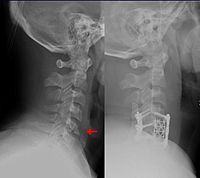
Changes in Reoperation After Publication of Consensus Guidelines on Margins for Breast-Conserving Surgery: A Systematic Review and Meta-analysis.
Sign Up to like & getrecommendations! Published in 2020 at "JAMA surgery"
DOI: 10.1001/jamasurg.2020.3025
Abstract: Importance The 2014 publication of the Society of Surgical Oncology-American Society for Radiation Oncology (SSO-ASTRO) Consensus Guideline on Margins for Breast-Conserving Surgery recommended a negative margin definition of no ink on tumor. Adoption of this… read more here.
Keywords: guideline; surgery; reoperation; reoperation rates ... See more keywords

Reoperation rates after posterior lumbar spinal fusion surgery according to preoperative diagnoses: A national population-based cohort study
Sign Up to like & getrecommendations! Published in 2019 at "Clinical Neurology and Neurosurgery"
DOI: 10.1016/j.clineuro.2019.105408
Abstract: OBJECTIVE The reoperation rate after lumbar degenerative disease surgery is low. It is difficult to find statistical differences in reoperation rates according to the different diagnoses of lumbar degenerative diseases. National population-based database overcomes the… read more here.
Keywords: lumbar degenerative; reoperation; national population; reoperation rates ... See more keywords

Do 30-Day Reoperation Rates Adequately Measure Quality in Orthopedic Surgery?
Sign Up to like & getrecommendations! Published in 2019 at "Joint Commission journal on quality and patient safety"
DOI: 10.1016/j.jcjq.2019.11.005
Abstract: BACKGROUND Unplanned reoperation rates represent an important metric in monitoring quality in orthopedic surgery. Previous studies have focused on 30-day reoperation rates, not accounting for complications that may arise beyond this time. This study aimed… read more here.
Keywords: orthopedic surgery; quality; quality orthopedic; year ... See more keywords

Percutaneous pinning versus volar locking plate fixation for dorsally displaced distal radius fractures- reoperation rates over an eight year period.
Sign Up to like & getrecommendations! Published in 2018 at "Journal of orthopaedics"
DOI: 10.1016/j.jor.2018.03.031
Abstract: Purpose To compare reoperation rates between closed reduction with percutaneous pinning (CRPP) and internal fixation with a volar locking plate (VLP) for the treatment of distal radius fractures. Methods A retrospective review of all patients… read more here.
Keywords: radius fractures; fixation; distal radius; reoperation ... See more keywords

Primary reverse shoulder arthroplasty using contemporary implants is associated with very low reoperation rates.
Sign Up to like & getrecommendations! Published in 2019 at "Journal of shoulder and elbow surgery"
DOI: 10.1016/j.jse.2019.01.026
Abstract: BACKGROUND The early results of reverse shoulder arthroplasty (RSA) were influenced to some extent by the use of first-generation implants and surgeons' learning curves, resulting in relatively high reoperation rates. The purpose of this study… read more here.
Keywords: shoulder arthroplasty; reverse shoulder; contemporary implants; shoulder ... See more keywords

Reoperation Rates and Mortality After Transurethral and Open Prostatectomy in a Long-term Nationwide Analysis: Have We Improved Over a Decade?
Sign Up to like & getrecommendations! Published in 2018 at "Urology"
DOI: 10.1016/j.urology.2018.04.032
Abstract: OBJECTIVE To assess long-term reoperation rates and mortality after transurethral resection of the prostate (TURP) and open prostatectomy (PE) as therapy for lower urinary tract symptoms due to benign prostatic enlargement. METHODS The present study… read more here.
Keywords: long term; turp open; reoperation rates; reoperation ... See more keywords

Postoperative Complications and Reoperation Rates Following Open Reduction and Internal Fixation of Ankle Fracture
Sign Up to like & getrecommendations! Published in 2018 at "Joints"
DOI: 10.1055/s-0038-1653949
Abstract: Purpose The purpose of this study was to determinate the overall postoperative complication and reoperation rates related to open reduction and internal fixation (ORIF) of ankle fractures. Methods All patients who had undergone an ankle… read more here.
Keywords: ankle fracture; open reduction; postoperative complications; reoperation rates ... See more keywords

Reoperation Rates Following Instrumented Lumbar Spine Fusion
Sign Up to like & getrecommendations! Published in 2018 at "SPINE"
DOI: 10.1097/brs.0000000000002291
Abstract: Study Design. A prospective cohort study. Objective. This study evaluated the cumulative reoperation rate and indications for reoperation following instrumented lumbar spine fusion (LSF). Summary of Background Data. LSF reduces disability and improves health-related quality… read more here.
Keywords: pathology; following instrumented; reoperation; rate ... See more keywords

Patient-Reported Outcomes and Reoperation Rates Following Lumbar Tubular Microdecompression: Six-year Follow-Up
Sign Up to like & getrecommendations! Published in 2022 at "Spine"
DOI: 10.1097/brs.0000000000004538
Abstract: Study Design. Prospective cohort study Objective. To report reoperation rates after lumbar tubular microdecompression (LTM) and to compare patient-reported outcomes (PROs) six years after surgery between those who did and did not need revision at… read more here.
Keywords: reoperation rates; reoperation; year; ltm ... See more keywords

Lateral Mass Screws Versus Pedicle Screws at C7 - Reoperation Rates for Adjacent Segment Disease (Operative ASD) and Nonunions (Operative Nonunions) in Posterior Cervical Fusions.
Sign Up to like & getrecommendations! Published in 2023 at "Spine"
DOI: 10.1097/brs.0000000000004597
Abstract: STUDY DESIGN A retrospective cohort study. OBJECTIVE To determine if there a difference in reoperation rates for symptomatic adjacent segment disease (operative ASD) and symptomatic nonunions (operative nonunions) in posterior cervical fusions (PCFs) stopping at… read more here.
Keywords: reoperation rates; operative nonunions; operative asd; disease ... See more keywords

Reoperation Rates Due to ASD following Primary 1-2 level MIS vs. Open TLIF.
Sign Up to like & getrecommendations! Published in 2023 at "Spine"
DOI: 10.1097/brs.0000000000004645
Abstract: STUDY DESIGN Retrospective analysis of prospectively collected data. OBJECTIVE To investigate the effect of the approach of the TLIF (open vs. MIS) on reoperation rates due to ASD at 2 - 4 year follow up.… read more here.
Keywords: reoperation rates; due asd; reoperation; rates due ... See more keywords